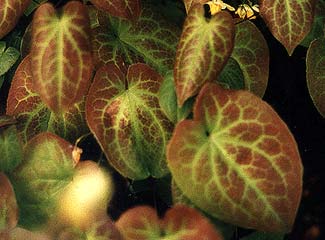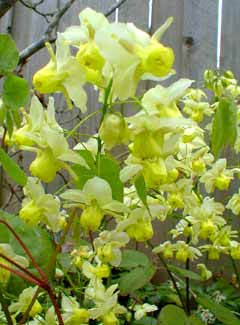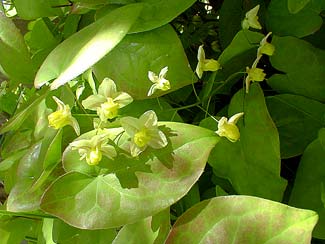 Yellow Epimedium
Yellow Epimedium
"When they return there will be mirth,
And music in the air,
And fairy wings upon the earth,
And mischief everywhere.
The maids, to keep the elves aloof,
Will bar the doors in vain;
No key-hole will be fairy-proof,
When green leaves come again."
-Thomas Haynes Bayly
(1797-1839)
(1797-1839)
Though I can't recall hearing anyone calling epimediums anything but epimediums in a good long while, they do have such common names as Barrenwort alluding to its herbal usage, Fairy Wings alluding to the pretty spiked flowers, & Bishop's Hat alluding to the colorfulness & shape of the leaf.
 Yellow Fairy Wings or Persian Barrenwort (Epimedium x versicolor 'Sulphureum') is a hybrid of two Eurasian species, E. grandiflorum & E. pinnatum colchicum.
Yellow Fairy Wings or Persian Barrenwort (Epimedium x versicolor 'Sulphureum') is a hybrid of two Eurasian species, E. grandiflorum & E. pinnatum colchicum.We planted a little start of it a few years ago under a huge Whitethroat Exbury Azalea, where it has spread into a gorgeous groundcover a foot tall its second year, & pushing toward two feet tall by its third year.
It has the most stunning leaves dancing in the slightest breeze on wiry-thin stems. These leaves get thicker & more splendid up to late autumn, when they begin to die back by about one-third to half.
Epimediums prefer considerable shade, though they'll survive in lots of sun if the ground never dries out. In shade they need much less water & are one of the few really easy dry shade plants for the more difficult areas of the garden. They do not grow thick & rampant & never need thinning, but they certainly can spread wider & wider, so can be divided in autumn if there's another location where another patch is wanted. I've several times just sliced pieces off of the edge of the spreading clump to give to friends.
 Yellow Epimedium can in particular be nearly evergreen through much of winter here on Puget Sound, but is so scruffy at winter's end that it is best to just cut it back before it begins to produce new spring growth. In a slightly more southerly zone, it can be more explicitely evergreen. But it's nice to cut it back at winter's end because then the small bright flowers will be more showy, appearing just ahead of new leaves.
Yellow Epimedium can in particular be nearly evergreen through much of winter here on Puget Sound, but is so scruffy at winter's end that it is best to just cut it back before it begins to produce new spring growth. In a slightly more southerly zone, it can be more explicitely evergreen. But it's nice to cut it back at winter's end because then the small bright flowers will be more showy, appearing just ahead of new leaves.About mid to late April & certainly by the start of May its leafage is fully renewed & vibrant. The flowers begin to appear about the same time as the new leaves start budding in late March or early April, so for a while there will be flowers amidst any unremoved scruffy leaves. The second photo shows the flowers in March. The third photo shows the flowers in late April by which time many fresh spring leaves have matured.
The flowers are largely spent by mid-May but for the rest of the year it has leaves even more beautiful than the flowers, beginning the year a mottled reddish bronze against pale & dark green veins, as shown in the May photo at page top. The clump's leaves retains a purple-veined appearance even as the leaves turn greener in summer.
We also have:
Red Epimedium (E. alpinum 'Rubrum')
& Lilafee Epimedium (E. grandiflorum 'Lilafee').
Red Epimedium (E. alpinum 'Rubrum')
& Lilafee Epimedium (E. grandiflorum 'Lilafee').